The biggest question about keeping our trailer instead of buying something new was the age and condition of the roof. John re-sealed it at least twice and we tried to stay on top of any potential leaks, so we figured it was likely not in terrible shape. But it would need an overhaul sooner rather than later. Since we were talking about a major increase in the size of our roof solar system, a roof redo should probably come first.
This is nothing new for anyone considering putting solar on a roof, RV or residential. It’s so much easier to do the roof first, then attach the panels.
As I previously mentioned in a post about removing propane from Howie, we found a great place to work on our trailer roof and so we parked at Camper John’s in Tennessee for a few days. The timing was quite lucky, as we were nearby in Tennessee anyway. They were able to fit us in on our time schedule, they focused completely on our job until they knocked it out, and they did quality work.
My plan is to make this post into more of a photo essay (with fewer words), so let’s see how that works out for me.
Our vehicles at Camper John’s, where we lived while they were doing the work. I was able to do some running on the quiet road alongside us and also spent some time on WiFi at the McMinnville library.
John used the opportunity to start disconnecting propane lines and everything related to the propane system. Including the tanks, which had been turned off for a month already:
“So, what do you think about removing the air conditioner?” Sure! It’s old and inefficient, it weighs a lot, it sticks up high over the roof. Most importantly, it was in the way of installing a larger solar system. We will be looking into the heat pump/mini split option to regain a cooling method eventually.
Time for another hole in the ceiling:
Thank you, air conditioner, you were very helpful on a few occasions!
The AC unit on the roof:
And then there was another hole in the roof – John removed the old bathroom fan and he will be installing a new one. Eventually… when the weather is nicer…
For now, the holes were ready for the roof redo. They would each get new plywood on top, insulation in the middle layer, and a piece of material to close up the ceiling. In the meantime, they would be covered in plastic to keep out bugs and construction dust.
Two small vent covers for the grey/black tanks were removed for the roof work and later reinstalled:
John was excited to get to help with all the fun work, especially the demolition-type stuff like pulling up the old membrane:
This exposed the old OSB (3/8″ oriented strand board) that was about to be replaced with plywood:
Checking out the front corner of the roof where water tends to pool – they didn’t find any moisture or mold/rot trapped there, just signs of old water damage from previous leaks that John had repaired. They would now replace some of the framing and seal everything up really well.
Oh, the things you’ll find when you start opening enclosed spaces. Pieces of history. For example, we once had an ant infestation. It was awful. We tried a lot of things and eventually had to close up the trailer and “bug bomb” it while we moved out briefly. I never want to do that again, so I’ve turned slightly fanatical about keeping bugs out of Howie. At least in any great number (like a number greater than 2 or so).
Anyway, this pile of long-dead ants brought up some memories!
Another bit of history, this one not so easily explained. One section of insulation seemed to be embedded with glass-like particles. John has a theory that there was an accidental “thermal event” during the manufacturing of the trailer, way back in 2006. Quite odd.
The guys at Camper John’s are super nice and we were comfortable living there. They let us hook up our electricity and offered water too in case we didn’t have enough in our tanks.
Hard at work on the roof:
Starting to install new framing:
John added some boards to use as anchor supports for the new solar panels, an added benefit to redoing the roof while already having a plan for the solar upgrade. Also of note, this is one of the last pictures I took with the awning still in place. Camper John had a use for it, we rarely open it, it was getting worn out, and it weighs enough to make it worth removing.
New plywood (on the left) and John’s anchor supports:
Some extra insulation to fill in the gaps:
New plywood is almost complete! They added a couple small holes for the tank vents plus the long thin one for the refrigerator vent. John took the opportunity to shift the fridge vent closer to the edge to make more room for solar panels.
Looking down into the refrigerator space:
One section left to finish out – the front edge which would get some extra protection against future water damage:
Taping the plywood in preparation for laying down a new membrane:
And… a rain delay. Everything went on pause for a couple days and Howie got tarped to protect the new work:
John used that time to continue with the propane removal project. Here he is dismantling the stove:
The big loud propane air heater – soon to be no more! We have switched to space heaters and again will be looking into the heat pump idea.
We were super lucky that Camper John collects trailer parts. He traded some labor for our propane generator, and he was interested in pretty much everything we offered to him. We weighed/recorded as much of it as we could, and I’ll be going into more details about the trailer weight in a future post. In the meantime, it was awesome to be able to get rid of a bunch of things that we consider extraneous, which in turn Camper John considers to be useful spare parts.
Starting the installation of the new (thicker) membrane:
Good as new – actually even better!
Just a couple vents and a blank space where the new bathroom fan will go. And a closer look at the front edge that got some needed TLC:
Overall we are really happy with what was accomplished that week. Another important step on making Howie an all-electric trailer!
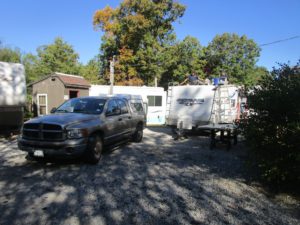
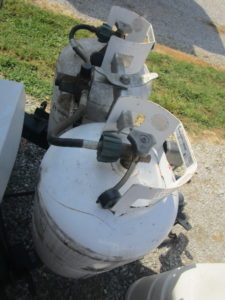

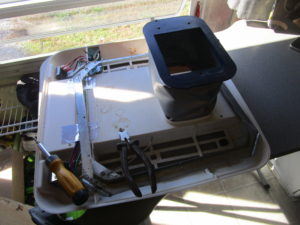

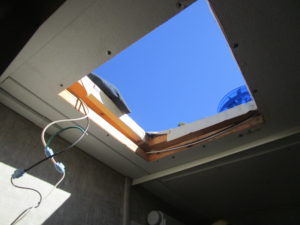
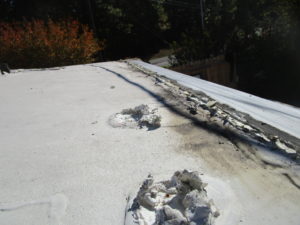
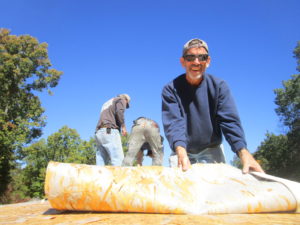
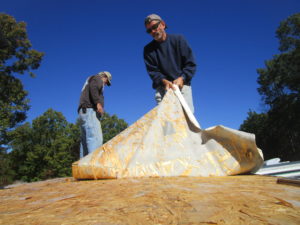
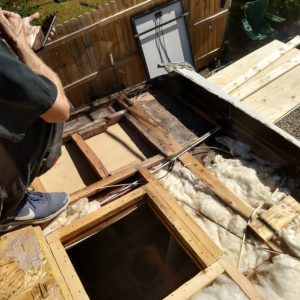

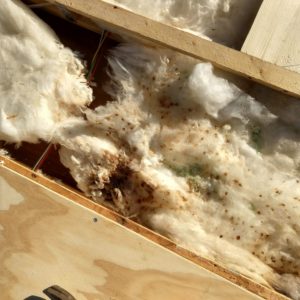
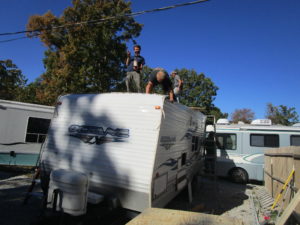
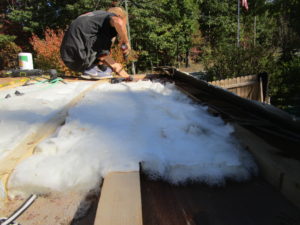
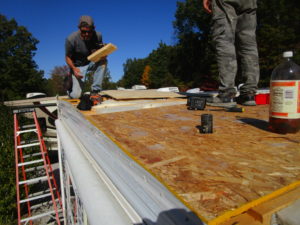
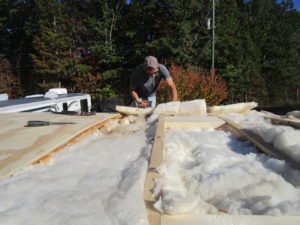

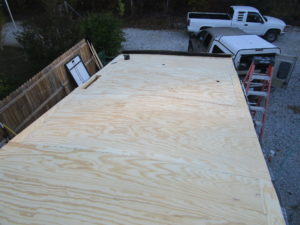

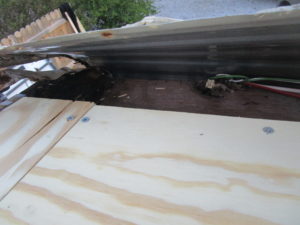




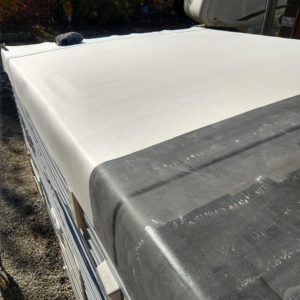

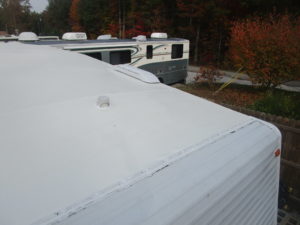
Thanks for all the snapshots. The outer membrane is white PVC. What is black layer underneath the outer membrane? I’m looking forward to learning about the solar panels installation.
Hi Marc!
John says it’s a two-layer membrane, white on top and black on the bottom, made of 60 mil Firestone rubber.
And I’m looking forward to writing (very soon) about the solar panel installation!
Thanks!
-Marcy